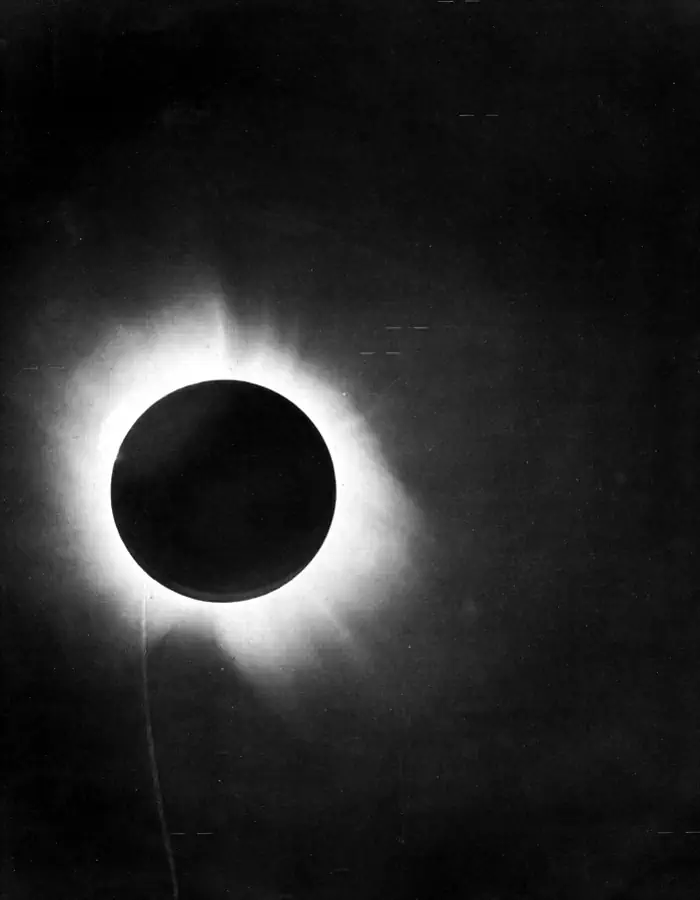On May 29, 1919, Einstein’s General Theory of Relativity, which was just four-year-old at the time, was put to its first test during a total solar eclipse. Albert Einstein’s prediction of the bending of light by the gravity of the Sun, one of the components of his general theory of relativity, could be tested by measuring how the images of stars shift when the sun is close-by.
Today’s (May 29) story of what happened this day in Science, Technology, Astronomy, and Space Exploration history.
How a solar eclipse proved Einstein’s general theory of relativity

Albert Einstein’s general theory of relativity, published in 1915, defined gravity as the influence of massive objects, like planets and stars, curving space around them.
If Einstein was right, then the light would also bend near massive objects. And in 1919, two British expeditions set out to test it by photographing a total solar eclipse. By comparing the position of stars with the sun in front of them and another with the sun elsewhere, English astronomer, physicist, and mathematician Arthur Eddington (28 December 1882 – 22 November 1944) and his team proved that the stars’ apparent positions moved during the eclipse.
This was the first, but not the last time Einstein’s general theory of relativity was tested and proven.
Einstein’s General Theory of Relativity suggests space and time form a four-dimensional fabric of spacetime. Spacetime is a mathematical model that combines the three dimensions of space and one dimension of time into a single four-dimensional manifold.
Massive objects like Sun can warp that fabric. Everything in the universe, including light, travels through spacetime. So, the light would bend near massive objects.
But, this theory cannot be tested in a lab since you can’t create objects massive enough to be able to measure the light-bending effect.
So, the total solar eclipse of May 29, 1919, was an excellent opportunity to test Einstein’s prediction. During that solar eclipse, the Sun would be crossing a distant star cluster scientists knew where these stars normally appeared in the sky.
If the General Theory of Relativity’s prediction was true, while the Sun was crossing in front of these stars, it would bend the fabric of spacetime and shift their apparent positions in the sky.
Normally, you can’t see the stars around the Sun because of its brightness. But, during a total solar eclipse, when the moon blocks the light of the Sun, the stars become visible.
Following Eddington’s lead, the Royal Society and the Royal Astronomical Society organized expeditions to the tropics of Brazil and to the island of Principe, where the total eclipse would be visible. The expeditions were organized under the direction of Sir Frank Watson Dyson.
The first expedition was led by Sir Arthur Eddington to the island of Príncipe (off the west coast of Africa), the second by the French astronomer Andrew Claude de la Cherois Crommelin (6 February 1865 – 20 September 1939) and the English astronomer Charles Rundle Davidson 28 February 1875 – 18 June 1970 to Sobral in Brazil. The stars that both expeditions observed were in the constellation Taurus.
Scientists successfully measured the shift of the apparent positions of stars in the sky created by the mass of the Sun. This proved that light gets curved near massive objects, as Einstein’s General Theory of Relativity predicted.
May 29 in Science, Technology, Astronomy, and Space Exploration history
- 1999: Discovery performed the first Space Shuttle docking to the International Space Station (ISS)
- 1919: Einstein’s general theory of relativity was proven on May 29, 1929, during a solar eclipse
Sources
- “Testing the General Theory of Relativity” on the NASA website
- “How a Total Solar Eclipse Helped Prove Einstein Right About Relativity” on Space.com
- Solar eclipse of May 29 1919 on Wikipedia
- “The solar eclipse that proved Einstein right” on the Earth Sky website
- “Einstein, Eddington and the 1919 eclipse” on the Nature website
- Moon Landings: All-Time List [1966-2025] - February 2, 2025
- What Is Max-Q and Why Is It Important During Rocket Launches? - January 16, 2025
- Top 10 Tallest Rockets Ever Launched [2025 Update] - January 16, 2025
